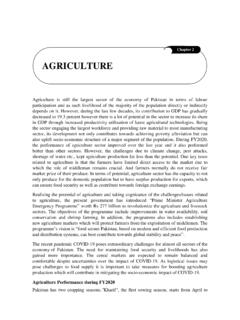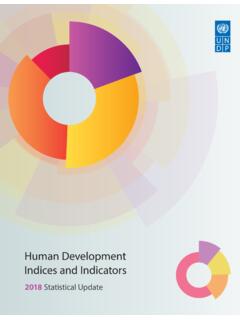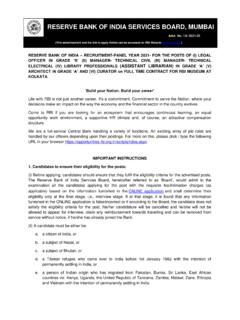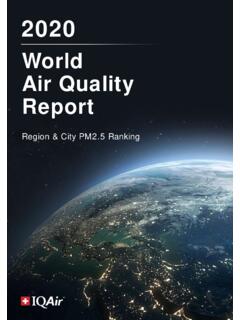Transcription of POVERTY IN PAKISTAN - Asian Development Bank
1 Asian Development BANK. POVERTY IN PAKISTAN . ISSUES, CAUSES AND INSTITUTIONAL RESPONSES. JULY 2002. C. Asian Development Bank All rights reserved The findings, interpretations, and conclusions expressed in this study are those of the authors and should not be attributed in any manner to Asian Development Bank (ADB) or the countries it represents. The Asian Development Bank encourages use of the material presented herein, with appropriate credit. Published by the Asian Development Bank PAKISTAN Resident Mission OPF Building, Shahrah-e-Jamhuriyat G-5/2, Islamabad, GPO Box 1863. PAKISTAN . Tel: (92-51) 2825011-16. Fax: (92-51) 2823324, 2274718.
2 Email: Publication Stock No. 070302. FOREWORD. POVERTY reduction has always been an important objective for the ADB and the Bank's POVERTY Reduction Strategy, approved in November 1999, articulated POVERTY reduction as ADB's overarching goal. In 2000, work on the POVERTY analysis for PAKISTAN was initiated as part of the process of developing the new Country Strategy and Program. This report describes the trends and key features of POVERTY in PAKISTAN , discusses its main causes, outlines existing programs and initiatives to reduce POVERTY , and gives a set of strategic options for ADB. A draft of this report was discussed at a high-level forum by representatives of the Government, private sector, civil society, and international Development agencies in April 2001.
3 The POVERTY analysis provides the basis for ADB's Country Strategy and Program for PAKISTAN for the period 2002 to 2006, approved in May 2002. The key findings of the POVERTY analysis and the discussions during the high-level forum and subsequent consultations are the basis of a partnership agreement between the Government of PAKISTAN and ADB. The agreement will formalize a sustainable partnership that sets out a long term- vision and agreed targets and strategies for POVERTY reduction. The report benefited from comments from the Government and other stake holders in PAKISTAN , and various ADB departments. The report was prepared by Safiya Aftab, Naved Hamid and Safdar Parvez.
4 Roshan Ara, G. M. Arif, Muhammad Irfan, Kemal, Martin Rimmer, and Rehana Siddiqui also made important contributions to the report. M. Ali Shah guided the preparation of the report and advised on important issues. Lynette Mallery provided photographs for the cover page and Shaista Hussain edited the report. Yoshihiro Iwasaki Director General South Asia Department ABBREVIATIONS. ADB Asian Development Bank AKRSP Aga Khan Rural Support Program CBO Community-Based Organization CSP Country Strategy and Program EOBI Employees Old Age Benefits EPA Environmental Protection Agency FBS Federal Bureau of Statistics FY Fiscal Year (July-June). GDP Gross Domestic Product GER Gross Enrollment Rate HDI Human Development Index HIES Household Income Expenditure Survey HRCP Human Rights Commission of PAKISTAN IPP Independent Power Producer IMF International Monetary Fund IMR Infant Mortality Rate IPRSP Interim POVERTY Reduction Strategy Paper JICA Japan International Cooperation Agency KPP Khushal PAKISTAN Program MHCHD Mahbub-ul-Haq Center for Human Development MSU Multi-donor Support Unit NEQS National Environmental Quality Standards NGO nongovernment organization NRSP National Rural Support Program NWFP North West Frontier Province OPP Orangi Pilot Project PIHS PAKISTAN
5 Integrated Household Survey PPAF PAKISTAN POVERTY Alleviation Fund PRSP Punjab Rural Support Program RSP Rural Support Program SAP Social Action Program SAPP Social Action Program Project SBA Standby Arrangement SBFC Small Business Finance Corporation SCOPE Society for the Conservation and Protection of the Environment SME Small and Medium Enterprises SPDC Social Policy Development Center SRSP Sarhad Rural Support Program TFR Total Fertility Rate UNDP United Nations Development Program WHO World Health Organization CONTENTS. FOREWORD. ABBREVIATIONS. EXECUTIVE SUMMARY 1. I. INTRODUCTION 7. II. POVERTY PROFILE. A. The Incidence of POVERTY 8. B.
6 Spatial Dimensions of POVERTY 11. C. Gender Dimensions of POVERTY 13. D. Vulnerability 14. E. Human Development 17. F. Environment 28. G. Characteristics of the Poor 30. III. CAUSES OF POVERTY . A. Poor Governance 33. B. Economic Determinants 36. C. Social Determinants 45. D. Environmental Degradation and POVERTY 50. IV. RESPONSES TO POVERTY . A. Public Sector 53. B. Non-Profit Sector and Civil Society 63. C. Private Sector 70. D. Potential For Public-Private-Civil Society Partnerships 72. V. CONCLUSIONS. A. Governance 76. B. Pro-poor Growth 77. C. Inclusive Social Development 78. D. Cross Cutting Concerns 78. BIBLIOGRAPHY. TABLES. POVERTY Trends in PAKISTAN in the 1990s 9.
7 POVERTY Trends in Rural and Urban Areas 11. POVERTY Trends by Province 12. Trends in POVERTY of Opportunity Indices 17. Human Development in South Asia 18. Gross Primary Enrollment Rate 1991 and 1999 21. Household Annual Expenditure Per Student on Education, 1998-99 24. Infant Mortality Rate 1991 and 1999 25. Immunization Trends in the 1990s 26. Percentage of Poor and Non-Poor Literate Household Heads, 1998-99 31. Demographic Characteristics of POVERTY , 1998-99 32. Trends in Investment 1988 to 2001 39. Pattern of Investment in the 1990s 39. Revenue and Expenditure Trends 1988 to 2001 41. Farm Classification by Size of Farm 46. Tenure Classification of Farms 46.
8 SAP-I Sectoral Allocation 59. SAP-II Sectoral Expenditure 60. SAP Achievements, 1991-99 61. Estimates of Philanthropic Contributions by Individuals in 1998 70. FIGURES. Income Distribution in PAKISTAN in the 1990s 10. Income Distribution Trends by Province 10. Literacy-Age Profile in Urban Areas 19. Literacy-Age Profile in Rural Areas 20. Sectoral Growth Rates in the 1990s 37. Inflation Rate in the 1990s 44. Trend in Worker Remittances 45. SAP Expenditure Trends 60. BOXES. Regional Pattern of POVERTY in Punjab 13. Chronic and Transient POVERTY 15. Learning Deficiencies and Low Achievement in Education 23. Ladder of POVERTY Reduction 31. Women in the Labour Force 43.
9 Power Patronage in Rural PAKISTAN 47. Trends in Growth and Human Development in PAKISTAN 50. Access to Justice Program 54. The Khushali Bank 56. SAP's Mixed Outcomes 61. SPDC Study on PAKISTAN 's Non-Profit Sector 64. Orangi Pilot Project (OPP) 67. Kashaf Foundation 67. EXECUTIVE SUMMARY. More than 12 million people were added to the poor in PAKISTAN been affected by sample selection issues) also registered an increase between 1993 and 1999. The rising POVERTY was the result of poor between FY1993 and FY1999. In governance and slow economic growth. The government has this period, the incidence of POVERTY adopted a comprehensive POVERTY reduction strategy to address in the Punjab increased from percent to percent; in Sindh this issue and ADB's operational strategy for PAKISTAN will from percent to percent.
10 Complement the Government's efforts in this regard. and in North West Frontier Province (NWFP) from percent to percent. There is very limited documentation on the gender POVERTY PROFILE of rural POVERTY ( percent) was dimensions of POVERTY ; however, it is significantly higher than urban clear that the gender discriminatory I t is generally accepted that the POVERTY ( percent). Inequality practices prevalent in Pakistani declining trend in POVERTY in also increased in PAKISTAN during the society shape men's and women's PAKISTAN during the 1970s and 1990s, in both urban and rural areas, choices and life opportunities 1980s was reversed in the 1990s.

















